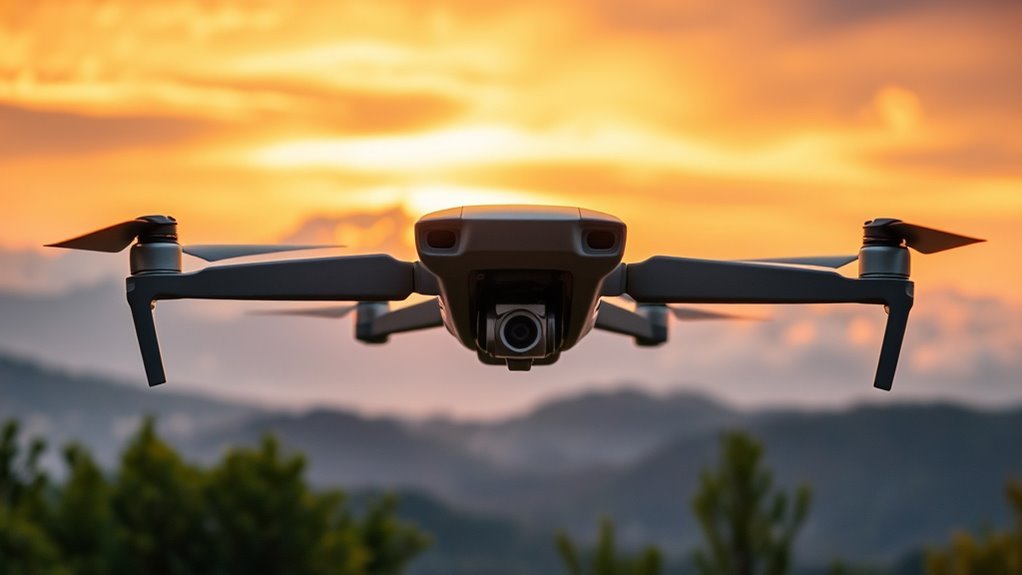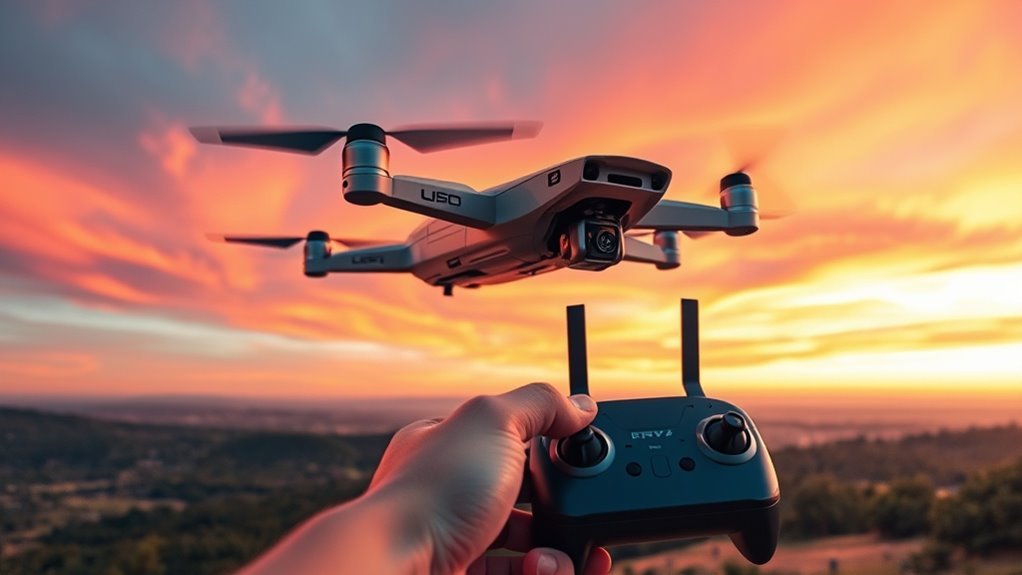Dr Drone Reviews gives you detailed, objective evaluations focused solely on drones, covering camera quality, flight performance, battery life, and ease of use. They analyze technical specs like lens sharpness, stabilization, and flight stability, helping you compare budget versus premium models. Safety features and expert maintenance tips guarantee safer, smoother flights. If you want to understand user feedback and keep up with emerging drone technology trends, exploring their insights will definitely add depth to your knowledge.
Overview of Dr Drone Reviews’ Approach

Although many review platforms provide general overviews, Dr Drone Reviews takes a more specialized approach by focusing exclusively on drone products and technology. When you rely on their insights, you benefit from an in-depth exploration into drone innovation, evaluating the latest advancements with a critical eye. Their market analysis is thorough, identifying trends and appraising how new features impact user experience and freedom of operation. You won’t find superficial comments here; instead, Dr Drone Reviews offers objective evaluations based on technical performance, usability, and value. This targeted methodology empowers you to make informed decisions in a rapidly evolving market, ensuring you select drones that truly align with your needs for autonomy and exploration.
Key Features of Popular Drones Reviewed

When evaluating popular drones, you’ll want to focus on camera quality, battery life, and flight performance. Each model offers distinct strengths in image resolution, flight duration, and maneuverability that impact overall usability. Understanding these key features helps you make an informed choice based on your specific needs.
Camera Quality Comparison
Camera performance is a crucial factor to take into account if you’re choosing a drone for photography or videography. When comparing camera quality, you’ll want to assess lens performance closely, as it directly impacts sharpness and color accuracy. High-quality lenses reduce distortion, enabling clearer, more detailed shots. Image stabilization also plays a significant role, especially if you plan to capture smooth video during flight. Effective stabilization minimizes blur caused by drone movement or wind, ensuring crisp footage. Additionally, sensor size and resolution influence image clarity and low-light capability, but lens quality and stabilization often determine the practical usability of your shots. By focusing on these elements, you can select a drone that offers both creative freedom and reliable, professional-grade visuals for your projects.
Battery Life Insights
Beyond image quality, how long your drone can stay airborne directly affects how much you can capture in a single flight. Battery life varies greatly among popular models, typically ranging from 20 to 35 minutes. To maximize this, consider battery longevity tips such as avoiding full discharges and storing batteries at ideal temperatures. Proper charging techniques are essential; use manufacturer-recommended chargers and avoid overcharging to preserve cell health. Fast charging might seem convenient but can reduce overall battery lifespan. Additionally, carrying extra batteries allows uninterrupted exploration, enhancing your freedom to capture more without rushing. Understanding these nuances helps you select a drone that balances flight time with your specific needs, ensuring that your aerial adventures aren’t cut short by unexpected power loss.
Flight Performance Highlights
Although battery life is essential, flight performance ultimately determines how effectively a drone responds to your commands and handles various conditions. When evaluating popular drones, flight stability stands out as a critical factor, ensuring smooth handling and minimizing drift during windy environments. You’ll appreciate drones with precise altitude control, as they maintain consistent heights without constant manual adjustments, enhancing your ability to capture steady footage or navigate complex spaces. Responsiveness to input commands also matters; a drone that reacts promptly provides you with a sense of freedom and confidence, especially in dynamic scenarios. Additionally, consider how well the drone compensates for environmental factors like gusts or uneven terrain. These performance highlights collectively influence your flight experience, allowing you to focus on exploration rather than constantly correcting flight behavior.
How Dr Drone Reviews Assesses Camera Quality

When evaluating drone cameras, Dr Drone Reviews focuses on several technical aspects to guarantee you get a clear understanding of image and video performance. They analyze the camera resolution to determine how sharp and detailed your photos and videos will be, ensuring you capture moments with clarity. Image stabilization is also rigorously tested, so your footage remains smooth even in windy conditions or swift movements. Additionally, Dr Drone Reviews examines:
- Sensor quality – impacting color accuracy and low-light performance.
- Lens versatility – affecting field of view and distortion.
- Video frame rates – essential for slow-motion and fluid playback.
Flight Performance and Battery Life Insights
Understanding a drone’s camera capabilities is only part of the equation; how the drone performs in flight and manages its battery life directly affects your overall experience. Flight performance hinges on factors like stability, speed, and how advanced navigation systems adapt to environmental conditions, ensuring you fly confidently within drone regulations. Battery life determines the freedom to explore without frequent interruptions.
| Aspect | Insight |
|---|---|
| Flight Stability | Responsive to wind gusts |
| Max Speed | Balances speed with control |
| Navigation | GPS with obstacle avoidance |
| Battery Capacity | 30 minutes typical |
| Regulatory Compliance | Adheres to local drone laws |
These metrics clarify what you can expect, empowering your aerial adventures without compromising safety or freedom.
User-Friendliness and Beginner Recommendations
When choosing a drone, you’ll want to evaluate models with intuitive controls that reduce the learning curve. Some beginner-friendly drones feature simplified interfaces and automated flight modes to help you get started quickly. Understanding these options can make your initial experience smoother and more enjoyable.
Easy Controls Overview
Although drones can appear complex at first, many models prioritize easy controls to enhance user-friendliness, especially for beginners. You’ll find that a well-designed drone offers an intuitive layout, making it simpler to navigate the controls without frustration. Control sensitivity is also vital; it guarantees your inputs translate smoothly into responsive movements, allowing you freedom to explore without feeling overwhelmed.
Here are three key elements to take into account:
- Intuitive layout: Clear labeling and logical placement of controls reduce the learning curve.
- Adjustable control sensitivity: Enables you to customize responsiveness according to your comfort level.
- Simplified mode options: Beginner modes limit advanced functions, giving you confidence as you learn.
Beginner-Friendly Models
Since mastering drone controls can be challenging at first, choosing beginner-friendly models is essential for a smooth learning experience. When selecting the best starter drones, focus on features like intuitive controls, stable flight modes, and durable builds that reduce crash risks. Models equipped with GPS positioning and automated return-to-home functions offer safety nets, allowing you greater freedom to explore without constant worry. Additionally, considering essential drone accessories such as extra batteries, propeller guards, and carrying cases enhances usability and extends flight time. These tools guarantee you maximize practice sessions and safeguard your investment. By prioritizing ease of use and practical add-ons, you’ll build confidence quickly, making your shift into drone piloting both enjoyable and efficient. This approach supports your desire for freedom while minimizing common beginner frustrations.
Learning Curve Tips
Even if you’re keen to take to the skies quickly, understanding the learning curve of drone piloting is essential for a successful start. You’ll want to leverage quality learning resources to avoid common beginner mistakes that can hinder progress or damage your drone. Focus on mastering fundamentals before attempting complex maneuvers.
Here are three key tips to ease your learning curve:
- Start with simulator training – practice virtually to build confidence without risk.
- Progress gradually – focus on basic controls and stable flight before advancing.
- Review tutorials and forums – engage with community insights to troubleshoot and improve.
Comparing Budget vs. Premium Drone Models
When deciding between budget and premium drone models, you’ll want to carefully evaluate factors like build quality, camera capabilities, and flight performance. Budget options often offer basic functionality suitable for casual use, but their materials and sensors may limit durability and precision. Premium features typically include advanced stabilization, higher resolution cameras, and extended flight times, enhancing your creative freedom and control. While budget drones can be a practical entry point, they might restrict your ability to capture professional-grade footage or execute complex maneuvers. On the other hand, premium models justify their cost by delivering superior reliability and versatility, essential if you seek to push boundaries in aerial photography or exploration. Ultimately, your choice should align with how much freedom and technical excellence you want from your drone experience.
Safety Features Highlighted in Reviews
Although drones offer remarkable capabilities, understanding their safety features is essential to guarantee secure operation. When you’re selecting a drone, reviews often emphasize critical safety components that align with current safety regulations and assure compliance during drone inspections. Key safety features include:
- Collision avoidance systems that use sensors to prevent crashes, giving you more freedom to focus on flight.
- Automatic return-to-home functions that activate during signal loss or low battery, safeguarding your investment.
- Geo-fencing capabilities that restrict flights in no-fly zones, assuring legal and safe operation.
These features collectively reduce risk and enhance your control without limiting your experience. By prioritizing drones with robust safety measures, you maintain freedom to explore while respecting regulations and inspection requirements.
Expert Tips Shared by Dr Drone Reviews
Understanding safety features sets a strong foundation, but mastering your drone’s capabilities requires more nuanced guidance. Dr Drone Reviews emphasizes regular drone maintenance tips such as checking propellers for damage, calibrating sensors, and updating firmware to guarantee peak performance and extend flight life. These practices reduce the risk of technical failures, allowing you to focus on freedom in the air. Additionally, refining aerial photography techniques is essential. You should experiment with camera angles, exposure settings, and flight paths to capture dynamic, high-quality images. Using manual controls rather than automatic modes often yields better results. By integrating these expert tips, you enhance both the reliability and creative potential of your drone, empowering you to explore and document your environment with confidence and precision.
Community Feedback and User Experiences
Since drone technology varies widely among users, gathering community feedback offers invaluable insights that go beyond technical specifications. When you explore user testimonials, you gain a clearer picture of real-world performance and potential limitations. User satisfaction often hinges on factors such as ease of use, durability, and responsiveness. Here are three critical aspects to evaluate from community feedback:
Community feedback reveals real-world drone performance and user satisfaction beyond specs.
- Reliability in diverse environments—how well the drone performs under varying conditions.
- Battery life and flight time—key for maximizing freedom and uninterrupted use.
- Customer support and firmware updates—essential for long-term satisfaction and device enhancement.
Emerging Trends in Drone Technology Covered
While drone technology continues to evolve rapidly, staying informed about emerging trends is essential if you want to make well-grounded purchasing decisions or keep your equipment up to date. Understanding the drone regulations impact is vital, as compliance shapes how you can operate freely. Future drone applications, from delivery to environmental monitoring, expand opportunities but also demand adaptability.
| Trend | Impact on Users | Regulatory Considerations |
|---|---|---|
| AI Integration | Enhanced autonomy, easier use | Requires updated safety protocols |
| Swarm Technology | Coordinated multi-drone tasks | Needs clear airspace rules |
| Extended Flight Time | Longer missions, broader scope | Battery disposal and usage rules |

